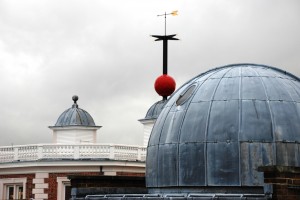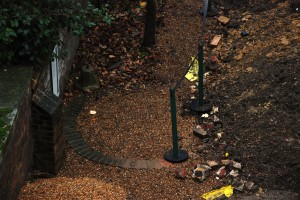I’ve yet to talk about my own research on this site, mostly because I’d like this to remain a ‘fun’ space, related to—but not dominated—by my real work. I’ve had an article on the relationship between Empire and the first Astronomer Royal under review for most of the past year, making me even more reluctant to write here about the Greenwich Observatory (RGO) for fear of scooping/contradicting/boring myself. But the observatory has been on my mind this week, so I decided to throw up a few photos I took during a winter visit.
Once you climb to the top of Observatory Hill (because of course you’re going to want to walk up there from Greenwich), you enter the observatory through an iron gate. To the right of the gate is the 24-hour Shepherd Clock, designed in 1852. Originally, the clock displayed astronomical time, but now it shows Greenwich Mean Time (of course). It may or may not reflect your time of arrival accurately, since it doesn’t keep track of British Summer Time. The Shepherd Clock is a slave clock, meaning that it’s controlled by a master clock elsewhere in the observatory.[1] Flamsteed would have been a lot less frustrated if the clock had existed during his tenure at the observatory. On the other hand, he had two Thomas Tompion clocks at hand, making him one of the most time-rich observers in London at the time.
If there’s one thing visitors know about the RGO, it’s that a brightly colored “time ball” drops every day at 13:00 GMT (BST in the summer). In theory, boaters on the Thames can synchronize their timepieces by the daily ball drop. In practice, boaters stopped looking to the observatory for this soon after the Great War, when the radio started providing time pips.
This unassuming patch of gravel is one of my favorite parts of the observatory. Once upon a time, this was the site of the well telescope. For many years, the existence of a well telescope at Greenwich was a matter of debate: did Flamsteed actually sink a shaft, install spiral stairs, and make nightly observations from the floor of the well? P.S. Laurie argued for the existence of a hole in which Flamsteed placed a telescope with a 87.5 foot focal length (seriously!).[1] In theory (again), Flamsteed used the instrument to observe gamma Draconis as it crossed the zenith, with the intent of compiling enough observations to calculate the star’s annual parallax. In practice, the well telescope was a failure. For one thing, Flamsteed had to lie on his back to use it. There’s no comfort to be found in lying on one’s back in the middle of the night at the bottom of the well. For another thing, the lens was chipped and cloudy and of little use to the astronomer.[2]
If I described all of the nifty things to see at the RGO (the time galleries, the camera obscura, the 28-inch refractor), you’d be reading this page for another several hours. You won’t be bored, and the planetarium and the Astronomy Centre have plenty of interactive exhibits to entertain the children. I’m not a child, but I spent quite a bit of time crashing imaginary spacecraft the last time I was in the Astronomy Centre. But take heed:
At the moment, the observatory is closed to the public. Why? Take a look at the view from the north side of Flamsteed House.
If you’ve been watching the 2012 Olympics, you probably recognize that Neoclassical building. The garden facade of the Queen’s House is getting quite a bit of air time, serving as a backdrop to the dressage and other equestrian events. Behind the Queen’s House and the National Maritime Museum, across the Thames, loom the Docklands. Just to the left of the Queen’s House, above the colonnade, you can see the line of the river and the embankment of the Isle of Dogs. If you cross to the Isle of Dogs and travel north past the skyscrapers (the building with the pyramidal top is the Canary Wharf Tower), across the A11, you will soon find yourself in Olympic Park.
The good news—if you’re in town for the duration of the Olympics, you need only hang on until August 4, when the RGO opens again to the public. Have a nice visit and say hello to the shell of Herschel’s telescope for me.
————————-
[1] It’s no longer controlled by a clock, but by a new quartz mechanism inside the building. The original master isn’t in working condition, but you can see it in the time galleries all the same.
[2] P. S. Laurie, “Flamsteed’s Well,” The Observatory 76 (1956): 24-5.
[2] A. Hunter and E. G. Martin, “The Flamsteed 90-Foot Lens,” The Observatory 76 )1956) 25-6.






